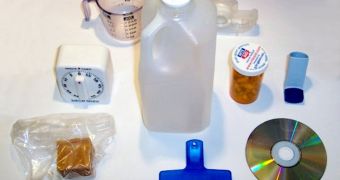Most plastic compounds in the world today are produced from chemicals that are derived from oil. Now, a new method allows for plastic to be turned back into the fossil fuel.
The team that created the machine capable of doing so says that their invention could in the near future ensure that plastic residues no longer pollute the land and ocean.
They are saying that, other than recycling, the excess plastic humankind produces and uses could be turned into fuel, that will power up our cars.
As such, the same batch of fossil fuels would perform a dual function, serving first as trays, bags and other plastic items, and then as fuel. This would reduce demand for oil altogether.
The thing about plastics is that the chemicals accumulate in runoff water, and make their way into the world's rivers, contaminating them and the marine animals within.
As the pollutants make their way into the ocean, and are broken up in smaller particles, they are picked up by currents, and taken to spots where more of these currents meet.
This is how the Pacific and Atlantic garbage patches appeared. They are spans of the ocean surface, hundreds of miles in diameter, where massive amounts of plastic and other junk have been accumulating for decades.
The material is also very difficult to get rid off, considering that it takes hundreds of years for it to break apart naturally.
In the mean time, it decreases in size, producing ever-finer particles which are ingested by marine wildlife such as phytoplankton and fish. This contamination eventually makes its way back to us.
Getting rid of plastics by burning them is also not an option, because the process releases massive amounts of the dangerous greenhouse gas carbon dioxide into the atmosphere.
“If we burn the plastic, we generate toxins and a large amount of CO2. If we convert it into oil, we save CO2 and at the same time increase people’s awareness about the value of plastic garbage,” Akinori Ito told Our World 2.0.
He is the CEO of Japanese company Blest, the group that developed the new device. The machines can be manufactured in several sizes, so that they meet as many needs as possible.
“To make a machine that anyone can use is my dream. The home is the oil field of the future,” Ito says.
He explains that, as far as conversion rates go, a single kilogram of plastic would take about 1 kilowatt of electricity to be converted into almost a full liter of oil.

 14 DAY TRIAL //
14 DAY TRIAL //